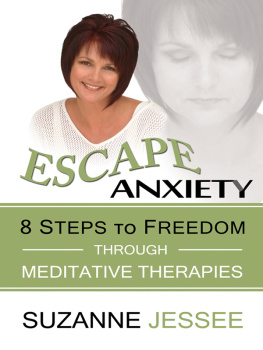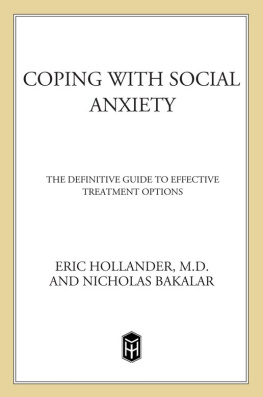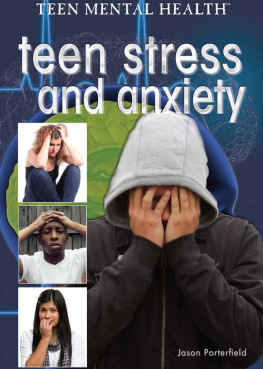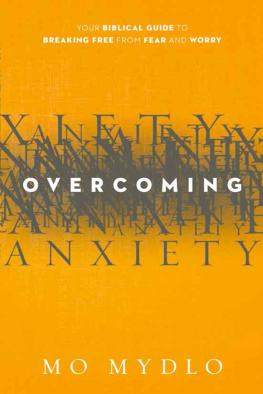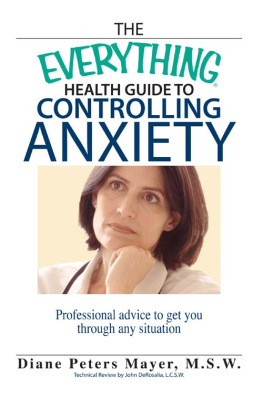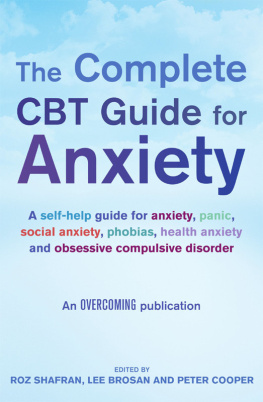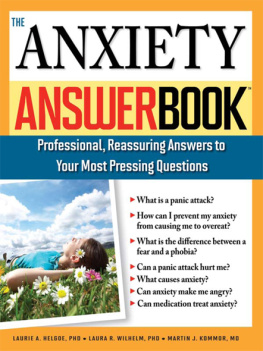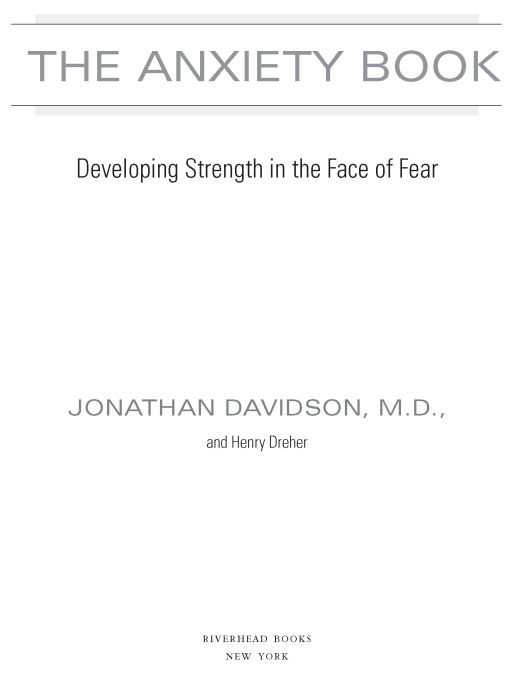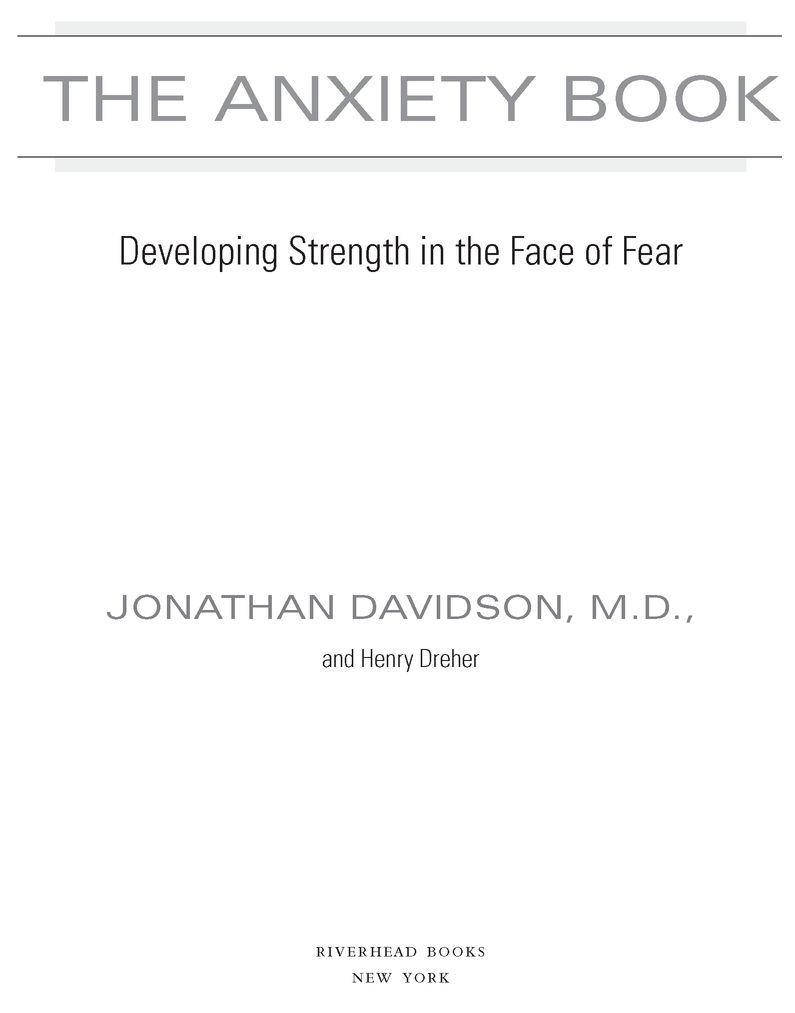Table of Contents
PRAISE FOR JONATHAN DAVIDSON, M. D., AND
THE ANXIETY BOOK
Easy to read and filled with solutions ranging from spirituality to meditation to medication to a healthy diet. Authors Jonathan R. Davidson, M.D., and Henry Dreher explain the hows and whys of anxiety, how to recognize its components and how to treat it. Its peppered with real-life examples of people you may recognize in yourself and how they dealt with fear and anxiety.
The Dallas Morning News
A lay readers guide on treating anxiety... Davidson successfully combines a self-help approach with his clinical experience, shining in his firm belief that within all anxiety sufferers lies the potential to control their disorder and regain an emotionally fulfilling life... a highly relevant choice.
Library Journal
There is no one better qualified than Jonathan Davidson to write such a book. Respected around the world, his work extends across the whole range of original research in psychiatry. He is a brilliant scholar and a true gentleman.
Randall D. Marshall, M.D., associate professor of clinical psychiatry,Columbia University College of Physicians and Surgeons, and director,Trauma Studies and Services, New York State Psychiatric Institute
Davidson sets a positive and compassionate tone throughout the text.... This is an excellent self-help resource.
Publishers Weekly
Dr. Davidson is unquestionably one of the foremost international leaders in the area of anxiety disorders and depression. What is most impressive in his body of work is its unmatched breadth, as it encompasses all anxiety and mood disorders.
Dr. Edna Foa, professor of clinical psychology in psychiatry,University of Pennsylvania, and director, Center for theTreatment and Study of Anxiety
Most Riverheaad Books are available at special quantity discounts for bulk purchases for sales promotions, premiums, fund-raising, or educational use. Special books, or book excerpts, can also be created to fit specific needs.
For details, write: Special Markets, The Berkley Publishing Group, 375 Hudson Street, New York, New York 10014.
This book is dedicated to my family... especially to Julia Kathleen, in the hope that she and her generation will know more of peace and less of fear than we do in ours.J.D.
For Sybil Leipow, Mike Dreher, and Jack and Deb Dreher.H.D.
ACKNOWLEDGMENTS
In contemplating our dangers with a disillusioned eye, I see great reason for intense vigilance and exertion, but not whatever for panic or despair.
Winston Churchill, THEIR FINEST HOUR, 1941
The stories you will read in this book are stories of courage, drawn from people who have suffered devastating anxiety, and have learned to face, and gain control over, their all-consuming fears. Unappreciated by most of us, however, is the torment, isolation, shame, and stigma that go along with disordered anxiety. Mark Twain put it well when he said, I have lived a terrible life, most of which has never happened. We can learn a great deal from the individual stories described in these pages; I know that I have been taught much by the many hundreds of patients whom I have been privileged to serve. The Anxiety Book is first and foremost a tribute to those who suffer from anxiety day in and day out, and to their courage in facing fear.
People follow their own pathways in coping with anxiety, but whichever one you choose, be sure that Winston Churchill said it right when he spoke of the exertion that is necessary to deal with danger, whether imagined or real. There is no one size fits all formula. Some create their own plans without professional input, some visit the clergy, others see their family doctors, and so forth. Some hold to a biological view and seek medications. Others strive to develop heightened self-awareness, yet others make progress through cognitive therapy. My own bent and special interests have drawn me to examine the role played by medications, understanding that they have strengths and limitations. I hope The Anxiety Book will serve as a balanced, comprehensive, and helpful guide to the different approaches that are available.
Over the years, many have helped in my own professional growth and, in one way or another, this book owes them a debt. Important turning points include the wonderful opportunities given to me at the Durham Veterans Administration Medical Center and at Duke University Medical Center to establish treatment and research programs in posttraumatic stress and other anxiety disorders. Jesse Cavenar and Bernard Carroll are acknowledged for their critical support in this context. I am glad to acknowledge other colleagues, including Jerilyn Ross, James Ballenger, Edna Foa, Derek Gander, Elizabeth Robertson, David Raft, Michael Liebowitz, David Sheehan, Norman Rosenthal, David Spiegel (at Stanford), David Spiegel (in Boston), Peter Fisher, Steven Straus, David Reilly, Wayne Jonas, Nathalie Koether, Larry Dossey, and Jerry Cott. Closer to home are my colleagues at Duke, including Ranga Krishnan, Allen Frances, Robert Califf, John Fairbank, Kathryn Connor, Jill Compton, Frank Keefe, Tom Lynch, and Kishore Gadde. The accomplishments of our Anxiety and Traumatic Stress Program at Duke would have been much less had it not been for such a dedicated and skillful team of colleagues, including Rebecca Smith, Pat Segee, Rita Davison, Nabila Danish, and my administrative coordinator, Sharon Lloyd. This book owes much to them.
Jill Compton played a critical role and contributed generously in making it possible for us to represent and integrate psychotherapy as part of the overall management of anxiety. We especially acknowledge her sizable contribution. Should any blemishes be found in the picture we have painted, the responsibility is fully that of the authors.
At Penguin Putnam, the expert guiding hand of our editor, Amy Hertz, has greatly enhanced The Anxiety Book. Her assistant, Marc Haeringer, has been unfailingly helpful. I also thank Susan Petersen Kennedy for her enthusiasm for The Anxiety Book. And I am indebted to our agent, Janis Vallely, who helped make the project possible and who also contributed integrally to our book. My coauthor, Henry Dreher, has described far more skillfully, sensitively, and accurately than I could ever do the struggles, fears, and victories of those individuals who were kind enough to share with us what it meant for them to live with severe anxiety. I wish to express my profound gratitude to all those patients who were willing to give of their time and their hearts to make this book possible.
Especial thanks go to my wife, Meg, for her continuing encouragement and support throughout this project. She helps to keep me grounded, maintain my sense of priority, and thereby remind myself that some days at least, there is enough time before rushing to work, to take the dogs for a walk or go out together for a bagel.
JONATHAN DAVIDSON, M.D.
I wish to join my coauthor in thanking Amy Hertz, our terrific editor, whose vision helped make this book possible, whose wise editorial guidance made it better, and whose support elevated the process. I, too, am indebted to our agent, Janis Vallely, whose shepherding of The Anxiety Book from conception to completion was as smart and sensitive as always, and whose friendship I value so greatly. I also thank Amys assistant, Marc Haeringer, and our copy editor, Brenda Goldberg, for doing great jobs, and Susan Petersen Kennedy of Penguin Putnam for being an ardent supporter of this project. Im grateful to my exceptional and always supportive transcriber, Terese Brown, and to Rachel Kranz for her invaluable assistance.


